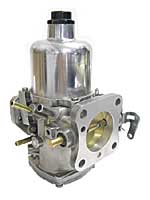Are these HIF6's or HS-6's?
The HIF6 has an integral float bowl:
The HS6 has a separate float bowl with a small line leading to the jet:
It can be a little easier to deal with the HS6 because it's far easier to take the lid off the float bowl and inspect the float and needle valve without taking the whole thing off.
First off, how do you know fuel isn't getting to the front carb? Just because it doesn't seem to be adding anything to the idle speed? Does it run on two cylinder when you drive it around?
I'm suspecting it's merely the idle balance between the two, the front carb has the throttle closed all the way, the back one is open and supplying all the air for the motor (via the balance tubes to the front 2 cylinders). If you don't have an air meter (I got an old used Uni-syn cheap on ebay years ago for balancing SU's, works for the DCOE's as well) it can be a bir tricky, but basically just find the idle adjusters, screw them in and out in small increments, until both have a similar effect on the idle speed when screwed in a half turn. Tighten them a half turn (opening the throttle slightly), note the effect on idle, then return. If one carb has less of an effect, then keep it screwed in slightly. Do this tighten/note/return iteratively until they are both balanced front and rear *and* the overall idle speed is where you want it to be.
Of course, this gets blended in with finely adjusting the mixture front and rear as well. You can't properly adjust the mixture until the air flow is balanced, and then without the mixture properly adjusted, the affect on idle isnt what it will be once it is. So it's iterative again, you have to go back and forth. It's a bit of a black art.
FWIW I used to have to lay hands upon the PV's SU's every few months. Just seemed to need periodic tweaking, like adjusting the valves. Probably keeps a lot of 'classic car' mechanics in beer money. I spent a while getting the Weber DCOE's set up on it initially, but since then it's probably been a good 5, 6 years and I simply haven't had to touch them a single solitary time since.




